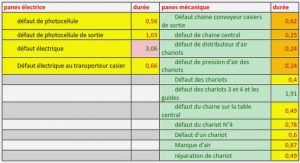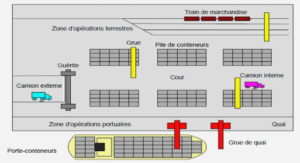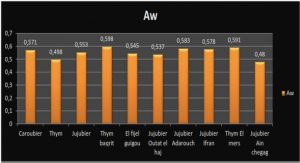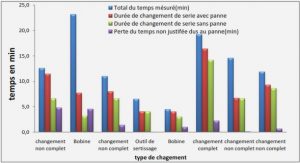Les diodes électroluminescentes
Il existe à l’heure actuelle deux méthodes utilisés dans l’industrie permettant d’obtenir des LEDs blanches. [1]
Méthode 1 : Mélange de LEDs de couleurs
La mise au point, par l’entreprise Nichia, [9] de LEDs bleues permet de produire de la lumière blanche à partir d’un mélange de LEDs rouges, vertes et bleues dans un même luminaire, spot ou « tableau » à LEDs. [1] Cette méthode à deux avantages : d’une part l’efficacité lumineuse globale est bonne et, d’autre part, elle permet de faire varier lesintensités lumineuses de chaque groupe de
LEDs afin d’obtenir la température de couleur et d’indice de rendu des couleurs (IRC) désirée (un bon IRC est proche de 100 et un bonne température de couleur est proche de 550k). C’est aussi la méthode la plus efficace en terme de consommation d’énergie pour le moment mais minoritaire sur le marché car trop onéreuse pour être intégrée à grande échelle. [2]
Méthode 2 : LED bleue et phosphore
Cette méthode est utilisée dans la majorité des LEDs blanches. [1] Elle est basée sur le principe de la fluorescence. Ces LEDs blanches sont fabriquées à partir d’une jonction p-n (diode) (voir annexe IV) à l’interface d’un empilement de couches minces de GaN en alliage avec l’indium (In x Ga1-xN). Intrinsèquement, ces LEDs à base de In x Ga1-xN donnent une émission bleue. Une couche luminescente à base de phosphore, déposée au-dessus, permet de convertir une partie du rayonnement émis en un rayonnement jaune. La lumière visible résultante est donc un mélange de bleu et de jaune, perçu par l’oeil comme un pseudo-blanc. Ces LEDs ont une efficacité lumineuse jusqu’à 90 lumens par watt selon les annonces de presse des grands fabricants (Nichia, CREE, Lumiled/Philips, OSRAM), ce qui est comparable avec une lampe fluorescente à basse consommation. Il faut noter, cependant, que ces valeurs d’efficacité sont pour des courants relativement faibles et que l’efficacité a tendance a chuter brusquement avec l’augmentation de courant injecté, à cause d’un phènomène qui s’appelle le « droop » (voir annexe V).
État de l’art
Actuellement, un déficit de luminosité de ces LEDs fait que le prix d’achat, pour un éclairage équivalent, est 50 fois supérieur à celui de lampes incandescentes (toutefois la consommation énergétique est nettement réduite, typiquement d’un facteur 4 comparé à une lampe à incandescence). [1]
La figure 1.7 est un diagramme en baton présentant les différentes pertes lors de la conversion du courant injecté dans une LED. Ces pertes ont lieu sous forme de chaleur. On constate que l’extraction de la lumière (« Extrakc. Eff. ») reste un problème majeur.
Oxydes conducteurs et transistors couches minces
ZnO comme oxyde conducteur transparent
Dans le domaine de l’électronique transparente, l’oxyde transparentconducteur (TCO) le plus utilisé est In 2O3 dopé par Sn (ITO). Mais depuis quelques années la tendance estau remplacement d’ITO par ZnO et plus particulièrement ZnO dopé par l’aluminium (AZO). Il y a plusieurs raisons à cela : premièrement In est toxique, rare et coûteux. Deuxièmement, ZnO peut être fabriqué sous forme cristalline à relativement basse température comparé à ITO [23]. Troisièmement, ZnO est plus facilement utilisable dans la fabrication de composants. En effet, la gravure chimique est couramment utilisée dans l’industrie pour la mise en forme des composants et ZnO est facilement gravé par les acides et les alcalins. Quatrièmement, les propriétés de ZnO peuvent être modifiées par le dopage. Par exemple, le dopage par le fluor permet d’obtenir une transparence dans le spectre visible supérieure à tous les autres TCO. Et, finalement, les caractéristiques de mobilité et de conductivité des électrons se sont améliorées depuis quelques années, ce qui permet à AZO d’avoir des résistivités comparables à ITO [24]. Ces propriétés ont permis à ZnO d’être adopté pour de nombreuses applications qui nécessitent un conducteur transparent : couche transparente pour filtrer la lumière UV, contacts transparents utilisés dans les écransplats, cellules solaires et LEDs. Ce sujet est développé dans les chapitres 2 et 5.
ZnO et ses applications en optoélectronique
Résumé
Ce chapitre est fondé sur un article analysant les différentes applications, dans le domaine de l’optoélectronique, réalisables avec ZnO déposé par PLD. Il analyse l’évolution croissante du nombre de publications dans ce domaine de recherche et discutes des futurs marchés importants.
Les applications décrites se focalisent d’une part sur ZnO sous forme de couches minces.
– composants électroniques : LED verte, LED UV hybride, TTFT,
– procédés de fabrication de composants optoélectroniques à basede GaN : couche sacrificielle dans le cas des fabrications des LEDs ou couche tampon pour la fabrication de cellules photovoltaïques, d’autre part, sur les applications de ZnO nanostructuré
– couche anti-reflets pour les cellules photovoltaïques.
Les résultats présentés dans cet article sont expliqués de façon plus approfondie dans les chapitres suivants.
Ma contribution dans les travaux de recherches présentées dans cet article concerne la fabrication et la caractérisation du composant TFT. La fabrication a necessité la mise en place d’un procédé de photolithographie par gravure chimique. La figure suivante décris les étapes successives de la fabrication d’un composant via ce procédé.
RESULTS & DISCUSSION
ZnO as a Transparent Conductive Oxide
Up till present, the most widely used Transparent Conducting Oxide (TCO) has been Sn-doped In 2O3 (ITO). Recently, there has been a trend towards the substitution of wurtzite ZnO for ITO (particularly Al doped ZnO (AZO)). There are several reasonsfor this. Firstly, In is toxic, rare and costly, none of which apply to ZnO. Secondly, ZnO can be readily fabricated in crystalline form at relatively low temperatures compared with ITO [7]. Thirdly, ZnO is easier to process due to a greater amenability to chemical etching and a superior resistance to hydrogen plasmas than ITO. Fourthly, the properties of ZnO can be readily tuned by doping. For instance, doping with F gives ZnO the highest optical transparency and the lowest plasma frequency of all TCOs. Finally, both the µ and σ attainable with ZnO have improved considerably over recent years and AZO can now give resistivities comparable with ITO [8]. These properties have led to the adoption of ZnO for a number of TCO applications, such as transparent coatings for filtering of UV light and transparent contacts for use in flat panel displays, solar cells and LEDs. Figure 5 shows a schematic and the response of a liquid crystal with ZnO-based transparent contacts grown on glass substrates by PLD.
Hybrid UV LEDs
ZnO has been proposed as an active material for use in LEDs. One of themain driving forces for this is the superior stability of the ZnO free exciton (table 1 shows that ZnO has an exciton binding energy of 60 meV, vs. 21meV for GaN) [19]. A key roadblock, however, is the development of reliable p-type doping. Indeed, high levels of p-type doping, are hard to achieve in ZnO. This is because it has proven difficult to incorporate and activate sufficient acceptor concentrations in order to overcome the intrinsic n-type nature of ZnO. Indeed, native defects (O vacancies and Zn intersitials) and common background impurities (such as H, Al, and Ga) act as donors in ZnO and compensate the acceptors [20]. As an alternative to ZnO homojunctions, LEDs based on hybridization with p-GaN may profit from the ZnO exciton binding energy and the mature p-type doping know-how of GaN. Figure 12 shows a schematic of a n-ZnO/ p-GaN:Mg heterojunction LED plus the corresponding electroluminescence (EL) spectrum [21].
INTRODUCTION
ZnO is a remarkable multifunctional material with a distinctive set of properties including a direct bandgap of ~3.37eV, high transparency over the visible spectrum, a very wide range of obtainable conductivities and a remarkably high piezoelectric response. Thus ZnO has many established and emerging applications including varistors, contacts, light emitting diodes [1] and surface acoustic wave devices [2]. Unidimensional ZnO structures, such as nanowires and nanoneedles, also have many potential applications based on this same property setaugmented with quantum phenomena of the nanoworld [3].
ZnO nanowires are often synthesised by vapor transport based on a vapor–liquid–solid (VLS) growth mechanism using a metal catalyst such as Au or Cu droplets [4,5,6]. In this case, the metal catalyst can act to both promote alignment of the ZnO nanostructures and to provide a template for their size and distribution [3]. Thus a method for obtention of a regular array of metallic nanodroplets of homogeneous form/size is required. However, recent studies show that well-aligned ZnO nanorods can be grown by Metal Organic Vapor Deposition (MOCVD) without using a metal catalyst [6].
This work reports on preliminary studies into the preparation and use of self-forming Au droplets as catalysts for the MOCVD growth of ZnO nanostructures.
EXPERIMENT
5 nm thick Au layers were deposited on 1cm x 1cm Si (100) and c-Al 2O3 substrates using thermal evaporation. Thermal annealing was employed in order to promote the formation of Au nanodroplets. The anneals were conducted at atmospheric pressure in air using a horizontal tubular furnace. The impact of annealing on the Au layer was studied as afunction of annealing time (from 30s to 5 min) and temperature (from 300°C to 800°C). ZnO was deposited by MOCVD in a water-cooled vertical quartz reactor with an inner diameter of 40mm in the growth zone. Dimethyl zinc triethylamine ((CH 3 ) 2Zn-N(CH2CH3 ) 3 ) was used as the Zn source and N 2O gas was used as the as an O source. The carrier gas was N2 and the flow rate was 44 500 sccm. The substrate was placed in the middle of the reactor on a graphite susceptor, which was inclined at 45° to the vertical. The susceptor was heated to 800°C during film growth using a radio frequency (rf) spire.
The sample morphology was studied using a Hitachi S4800 Field Emission-Scanning Electron Microscope (FE-SEM). The local composition was investigated in situ in the SEM using an Energy Dispersive X-ray (EDX) micro fluorescence system. “IMAGE-J” software was used in order to do statistical analysis of the Au droplet distribution [7].
EXPERIMENT
Both Si (111) and c-plane sapphire (c-Al2O3 ) were used as substrates for the three growth processes A. MOCVD ZnO was deposited by MOCVD [Fig. 1(a)] in a watercooled vertical quartz reactor with an inner diameter of 40 mm in the growth zone. The Zn source was dimethyl zinc triethylamine (DZT) [(CH 3 ) 2Zn-N(CH2CH3 ) 3] and the carrier gas was N 2 . The flow rate was 500 SCCM (SCCM denotes cubic centimeter per minute at STP) for the carrier gasand the DZT combined. N2O gas was used as the O source and its flow rate was also 500 SCCM. The substratewas placed in the middle of the reactor on a graphite susceptor, which was inclined at 45° to the vertical. The susceptor was heated to 800 °C during film growth using a radio frequency (rf) coil. B. PVT ZnO was deposited by carbothermal evaporation in a tubular furnace with an inner diameter of 30 mm [Fig. 1(b)]. A 2g (1:1 mass ratio) mix of ZnO and graphite powders was used for the growth and covered a 1 cm 2 surface. N 2 was used as the carrier gas at 80 SCCM gas flow rate. Both outlets of the furnace were kept open to ambient air. A ceramic holder with the powder was inserted into the quartz tube when the furnace temperature stabilized at 1100 °C. The c-Al 2O3 and Si (111) substrates were placed with a distance of 5 cm from the end of the powder boat to the beginning of the substrate. The reaction time was 30 min.
RESULTS
SEM investigations
SEM images for MOCVD growth of ZnO
SEM images for MOCVD growth of ZnO on c-Al2O3 . Figure 2(a) is a SEM image for a MOCVD growth on c-Al 2O3. The image shows a forest of microcolumns/wires of rather uniformdiameter and length (typically 1.5 and 30 µm, respectively). The majority of the columns have a preferred orientation perpendicular to the substrate plane. The higher magnification image shown in Fig. 2(b) reveals that some of these microstructures are partially hollowed, such that the best description of their form might be hexagonally faceted nanotubes. The origin of this hollowing is still underconsideration.
PL investigations
PL spectra for all samples (Figs. 11 and 12 and Tables III and IV) showed an ultraviolet UV band and a green band [N.B. there is a gap in all spectra at around 488 nm due to the second harmonic peak of the UV laser (244 nm) used for this experiment]. The UV emission was indexed as ZnO near band edge (NBE) emission19 and the green emission was attributed to defects in the ZnO.[20] The NBE emission wavelength and FWHM were lower for the structures grown on Si substrates than for those grown on c-Al 2O3 . The NBE emission wavelengths max were also observed to depend on growth technique. The structures grown by PLD had the shortest NBE max 380.0 nm on Si and 380.3 nm on c-Al 2O3and the structures grown by PVT had the longest max 387.5 nm on Si and 391.5 nm on c-Al 2O3 . Structures grown by MOCVD had NBE max at 382.3 nm on Si and 383.5 nm on c-Al 2O3 . The intensity of the PL peak for the nano-ZnO grown on c-Al 2O3 and by MOCVD (Table IV) is more than an order of magnitude higher than those for the structures grown by PLD and PVT. The lower NBE max and smaller FWHM for structures grown on Si compared to those grown on c-Al 2O3 could be related to Al diffusion from the c-Al 2O3 substrate, which the authors have observed by secondary ion mass spectroscopy in ZnO thin films grown at similar temperatures.[21]
EXPERIMENT
ZnO nanostructures were grown by PLD from a 99.99% pure sintered ZnO target using a KrF excimer laser (248 nm) at a frequency of 10 Hz. The vacuum chamberwas evacuated using a turbomolecular pump to a pressure of about 1×10 −6 Torr. The impact of growth conditions was investigated as a function of both Ar partial pressure (PAr ) and growth temperature (Ts). Si (111) was chosen as the substrate and growths were all made for a duration of about 10 minutes. Sample morphology was studied using a Hitachi S4800 Field Emission-Scanning Electron Microscope (FE-SEM). The crystal quality of the nanostructures was investigated using X-Ray Diffraction (XRD) performed in a Panalytical MRD Pro system using Cu Kα radiation. Optical properties were studied via Room Temperature (RT) PhotoLuminescence (PL) with a continuouswave, frequency-doubled, argon-ion laser (244 nm, power of 30mW). Heterojunction LEDs were made by growing n-type ZnO nanostructures on p-type Si (111) substrates. Device I/V characteristics and electroluminescence (EL) were investigated using a Karl-Suss probe station, a Keithley 2400 Source-Meter and an Olympus digital camera.
RESULTS & DISCUSSION
The Dependence of the Nanostructures on Growth Conditions
Figure 1 shows SEM images of samples obtained under various growth conditions. The lower and intermediate Ts gave films with a relatively high surface roughness but no distinct nanostructures. Samples grown at higher Ts showed dense arrays of vertically-aligned nanostructures. Growths at higher P Ar gave nanorods about 200 nm in diameter and 3 microns in length, which wererounded at the tips. Samples grown at lower PAr gave a “moth-eye” type array of nanocones [8,9], which were about 3 microns in length and 200 nm in diameter at the base.
Introduction
During the last decade, zinc oxide nanostructures have been extensively studied due to their potential relevance in optoelectronics, spintronics and bioapplications [1]. Pulsed laser deposition (PLD) is recognized as one of the most powerful techniques for the growth of ZnO-based thin films and it has recently shown a tendency for the growth of self-organizing ZnO-based nanostructures arrays [1–3].
In previous studies [4], it was found that self forming arrays of vertically aligned nanocolumns and nanocones can be grown by PLD under optimized growth conditions. It was proposed that such arrays of nanostructures could be useful for enhancing light extraction and/or absorption in optical devices. Indeed, simple p–n heterojunction LEDs made with such n-type ZnO nanocone arrays grown on p-type Si were found to give rectifying characteristics and blueish–white electroluminescence which was visible to the naked eye [5]. The purpose of the present work is to examine the morphological and optical properties of these PLDgrown ZnO nanostructure arrays by scanning electron microscopy (SEM), photoluminescence (PL) and angle resolved reflectivity (ARS). The sample optical properties will then be discussed and correlated with their morphological and structural properties.
Experimental
Substrates of Si (111) and c-plane sapphire (c-Al2O3 ) were used for the growth of the ZnO nanostructures. The samples were grown by PLD from a 99.99% pure ZnO target using a KrF excimer laser (248 nm) as described elsewhere [3–5]. The sample morphology was studied using a Hitachi S4800 field emission-SEM. X-ray diffraction (XRD) wascarried out in a Panalytical MRD Pro system in order to investigate the crystal structure of the samples. Optical properties were assessed by PL and reflection. For the PL measurements, the samples were mounted on a cold finger in a continuous flow cryostat permitting temperature control in 14K to room temperature (RT) range. A He–Cd laser (0.6W/cm2) was used as the excitation source. The sample emission was dispersed using a SPEX1704 spectrometer and detected using a cooled photomultiplier. RT reflection measurements were performed using an Ocean Optics UBS4000 spectrometer and computer-controlled rotation stages. The samplewas illuminated with a collimated beam of a tungsten/halogen lamp. The rotation stages and the spectra acquisition were piloted with homemade software.
Results and discussion
Figure 1 shows typical SEM images of the two kinds of nanostructure arrays observed in the samples. Figure 1(a) reveals nanocolumns of rather uniform shape, aligned preferentially along the perpendicular to the Si (111) substrate plane. They are averaged 200 nm in diameter and about 3mm in length. Figure 1(b) shows the ‘moth-eye’ type array of nanocones, which was obtained on the same substrate by changing the growth conditions [4, 5]. The nanocones are also aligned preferentially along the perpendicular to the substrate plane and are typically 3 µm in length with an average diameter of about 200 nm at the base. Five samples were selected for studies: nanocolumns/c-Al 2O3 , nanocolumns/n-Si (111), nanocones/c-Al 2O3 , nanocones/n-Si (111) and nanocones/p-Si (111).
|
Table des matières
Liste des abréviations
Introduction
I Contexte
1.1 Avant propos : Nanovation
1.2 La PLD, la MOCVD et la PVT
1.3 L’oxyde de zinc
1.4 Applications à l’optoélectronique
1.4.1 Les diodes électroluminescentes
1.4.2. Les cellules photovoltaïques
1.4.3 Oxydes conducteurs et transistors couches minces
II ZnO et ses applications en optoélectronique
ZnO Thin Films & Nanostructures for Emerging Optoelectronic Applications
Conclusion
III Mise en place d’une approche pour la fabrication de ZnO nanostructuré
3.1 MOCVD Growth of ZnO Nanowires Using Au Droplets as Catalysts
3.2 Comparison of ZnO nanostructures grown using pulsed laser deposition, metal organic chemical vapor deposition, and physical vapour transport
Conclusion
IV Dépôts de ZnO par PLD pour la fabrication de LEDs et de PVs
4.1 Fabrication of Nanostructured Heterojunction LEDs Using Self-Forming“Moth-Eye” Type Arrays of n-ZnO Nanocones Grown on p-Si (111) Substrates by Pulsed Laser Deposition
4.2 Morphological and optical studies of self-forming ZnO nanocolumn and nanocone arrays grown by PLD on various substrates
4.3 Growth of “moth-eye” ZnO nanostructures on Si (111), c-Al 2O3 , ZnO and steel substrates by PLD
4.4 Use of “moth-eye” ZnO nanostructures on Si (111) as templates for MOVPE growth of GaN
Conclusion
VI Dépôts de ZnO par PLD pour la fabrication de TFT et TCO
5.1 Thin film transistors with wurtzite ZnO channels grown on Si 3N4/SiO 2 /Si (111) substrates by pulsed laser deposition
5.2 Amorphous ZnO Films Grown by Room Temperature Pulsed Laser Deposition on Paper and Mylar for Transparent Electronics Applications
Conclusion
Conclusions de ce travail de recherche
Etape 1 : Choix d’approche de croissance de nanostructures
Etape2 : Etude de la croissance de réseaux de nanostructures de ZnO sans catalyseur sur different substrats
Etape 3 : Fabrications de composants
ANNEXE I Outils de Caractérisations
I.1 Microscopie électronique à balayage
I.2 Photoluminescence
I.3 Microscopie à force atomique
I.4 Diffractométrie de rayons X
I.5 Cathodoluminescence
I.6 Réflexion spéculaire
ANNEXE II Les matériaux semi-conducteurs
ANNEXE III Structure de bande de ZnO
ANNEXE IV Luminescence d’un semi-conducteur et extraction de la lumière
ANNEXE V Novel Green Light Emitting Diodes: Exploring Droop-free Lighting Solutions for a
Sustainable Earth
ANNEXE VI Epitaxial MOVPE growth of highly c-axis oriented InGaN/GaN filmson ZnO-buffered Si (111) substrates





